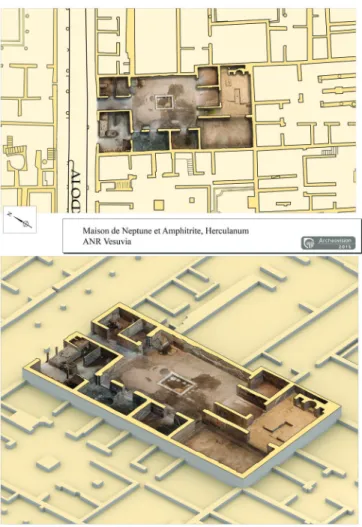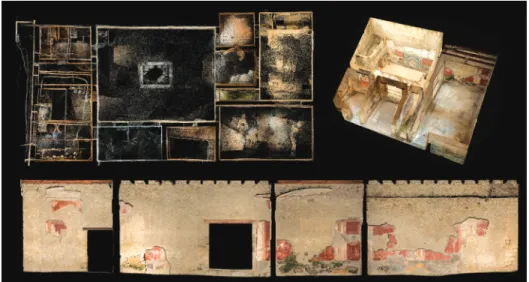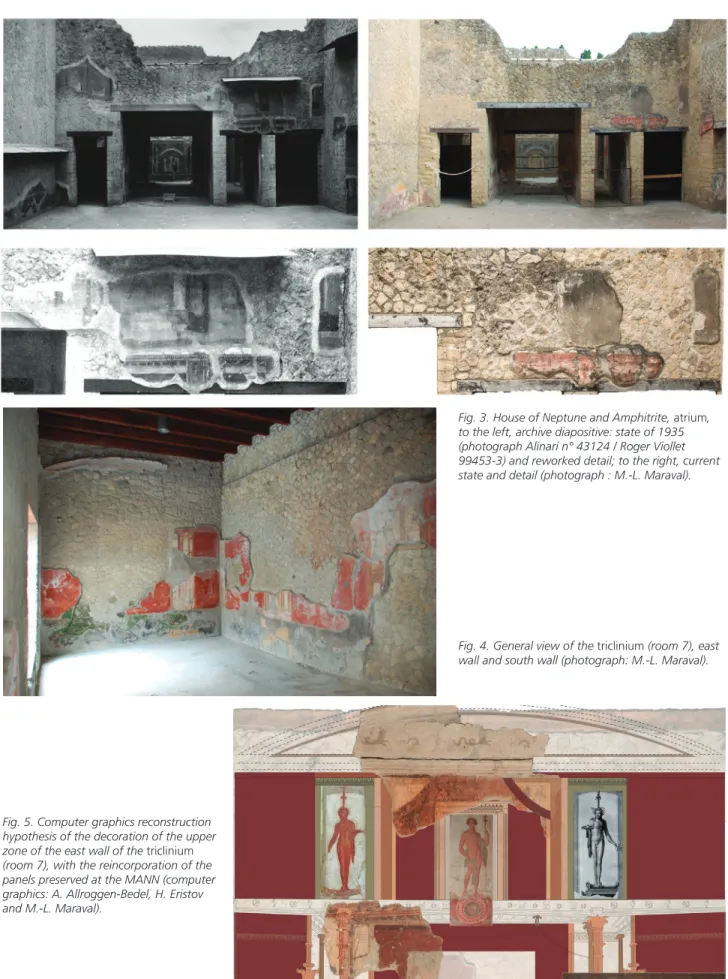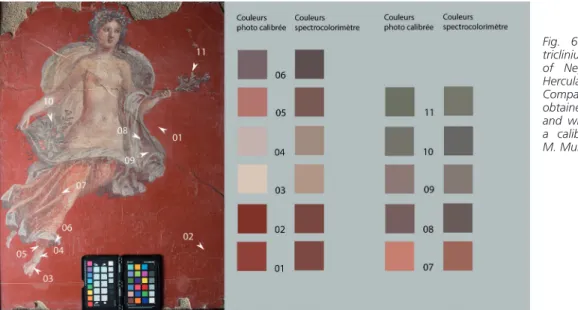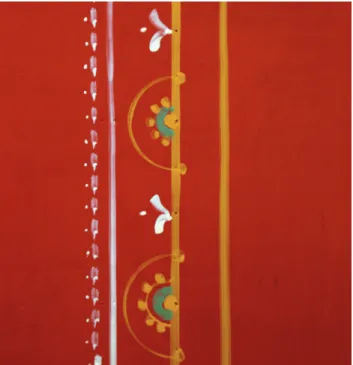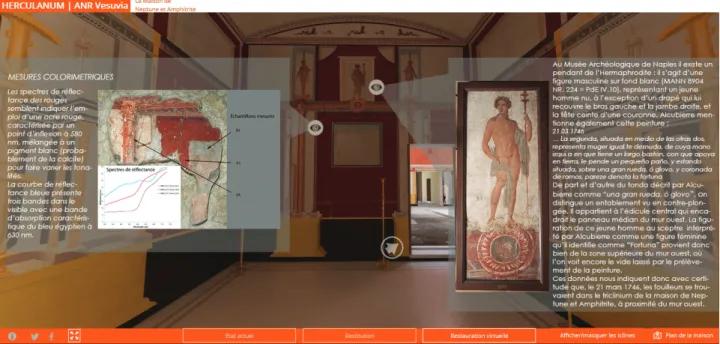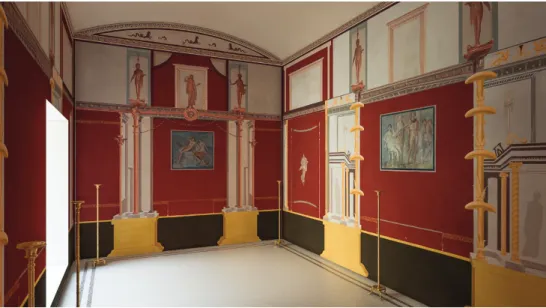HAL Id: hal-03151942
https://hal.archives-ouvertes.fr/hal-03151942
Submitted on 25 Feb 2021
HAL is a multi-disciplinary open access
archive for the deposit and dissemination of
sci-entific research documents, whether they are
pub-lished or not. The documents may come from
teaching and research institutions in France or
abroad, or from public or private research centers.
L’archive ouverte pluridisciplinaire HAL, est
destinée au dépôt et à la diffusion de documents
scientifiques de niveau recherche, publiés ou non,
émanant des établissements d’enseignement et de
recherche français ou étrangers, des laboratoires
publics ou privés.
Distributed under a Creative Commons Attribution - NonCommercial - NoDerivatives| 4.0
International License
Reconstruction of ancient wall paintings: digital
painting and three-dimensional restoration of the House
of Neptune and Amphitrite in Herculaneum
A Dardenay, M Mulliez, P Mora
To cite this version:
A Dardenay, M Mulliez, P Mora. Reconstruction of ancient wall paintings: digital painting and
three-dimensional restoration of the House of Neptune and Amphitrite in Herculaneum. Virtual Retrospect
2017, Maud Mulliez; Caroline Delevoie, Nov 2017, Pessac, France. pp.67-77. �hal-03151942�
M.Mulliez, éd. (2019), Restituer les couleurs // Reconstruction of Polychromy,
Actes du Colloque Virtual Retrospect 2017, Archeovision 8, Éditions Ausonius, Bordeaux
Tiré-à-part des Actes du colloque
Virtual Retrospect 2017
Conditions d’utilisation :
l’utilisation du contenu de ces pages est limitée à un usage personnel et non commercial.
Tout autre utilisation est soumise à une autorisation préalable. contact@archeovision.cnrs.fr
A. Dardenay, M.Mulliez, P.Mora
Reconstruction of ancient wall paintings:
digital painting and three-dimensional
restoration of the House of Neptune
and Amphitrite in Herculaneum
pp.67-77
a
usonius
Reconstruction of ancient wall paintings:
digital painting and three-dimensional
restoration of the House of Neptune
and Amphitrite in Herculaneum
Alexandra Dardenay, TRACES (UMR 5608), Université Toulouse
adardenay@yahoo.fr
Maud Mulliez, ArScAn (UMR7041), Archeovision (UMS 3657)
maud@maudmulliez.com
Pascal Mora, Archeovision Production
pascal.mora@u-bordeaux-montaigne.fr
Résumé : L’un des objectifs du programme ANR VESUVIA (Vivre Ensemble : Société et Urbanisme d’une Ville de l’Italie Antique) est de reconstituer les différentes phases de l’architecture et de l’ornatus des maisons d’Herculanum. Parmi ses achèvements, le projet prévoit de diffuser une partie de ses méthodes et de ses résultats à travers la réalisation d’un modèle 3D de restitution de la Maison de Neptune et Amphitrite à Herculanum (V, 6-7). Dans cet objectif, sont réalisées des infographies de restitution des décors de plusieurs pièces de la maison, lesquelles sont ensuite insérées dans un modèle 3D de la maison.
La finalisation des infographies des parois peintes est réalisée selon une technologie de peinture numérique particulièrement novatrice.
Grâce à un croisement avec le programme de recherche Retro-Color3D porté par Archeovision, la restitution “totale” des peintures murales a pu bénéficier du travail de recherche effectuée dans ce cadre. L’objectif de Retro-Color 3D était de trouver une méthodologie permettant de rendre à des objets archéologiques (sculpture peinte ou peinture murale) leurs couleurs d’origine en y intégrant les effets de matières et d’irrégularité qui procèdent nécessairement d’un travail artisanal. Le triclinium 7 de la maison de Neptune et Amphitrite en a été l’un des cas d’étude. La restauration numérique des peintures nécessitait de définir les couleurs et leur rapport entre elles le plus justement possible (par mesures colorimétriques) et de trouver comment les reproduire. C’est l’ensemble des résultats produits par ces recherches qui est présenté ici.
Mots-clefs : enduits peints, Herculanum, peinture romaine, architecture romaine, peinture numérique, restitution 3D, restauration numérique
Abstract: One of the aims of the ANR VESUVIA programme (Vivre
Ensemble : Société et Urbanisme d’une Ville de l’Italie Antique)
is to reconstruct the various phases of the architecture and the
ornatus of houses in Herculaneum. The project also aims to
disseminate some of its methodology and results by creating a three-dimensional reconstruction of the House of Neptune and Amphitrite at Herculaneum (V, 6-7). To this end, visuals of the decorative schemes of several rooms of the house were created using computer graphics and subsequently incorporated into the 3D model of the house.
The digital restoration of the painted walls used a particularly innovative methodology based on the research carried out by the Retro-Color3D programme supported by Archeovision. The objective of the Retro-Color 3D research programme was to develop a methodology that makes it possible to restore the original colours of archeological objects such as painted sculptures or wall paintings by incorporating the effects of texture and irregularities intrinsic to the craft. The triclinium (room 7) of the House of Neptune and Amphitrite presents a case study of this method.
The successful digital reconstruction of the paintings was dependent on the ability to define the colours and their relationship to each other as accurately as possible (using colometric measurements) and to find a way of reproducing them.
The overall results of this research are presented here.
Keywords: painted plaster, Herculaneum, Roman painting, Roman architecture, digital painting, 3D reconstruction, digital restoration
INTRODUCTION: PRESENTATION OF THE ANR VESUVIA PROGRAMME
Herculaneum 1 disappeared during the eruption of Mount
Vesuvius in 79 AD, which had also buried Pompeii. It was, however relatively ignored by archaeological and historical studies, which concentrated on its famous neighbour. Nonetheless, the outstanding preservation of the archaeological site and the abundance of archival documentation would make it possible to carry out a systematic analysis of the buildings, the furniture and the painted or sculpted decoration, which could be reconstructed in their original context: all this data could subsequently feed into a larger study of the living conditions, the social network and the specificities of Herculaneum, compared to the other Campanian cities and, more specifically, Pompeii 2. This is how the VESUVIA 3 programme
(ANR-CNRS-University of Toulouse came into being: encompassing an architectural, sociological and anthropological study of the domestic sphere in Herculaneum. For the publication of the results and to summarise the data acquired, the team created computer graphics to reconstruct the architecture and the decorations of the houses, which was then inserted into 3D computer models.
The Director of the Parco Archeologico di Ercolano authorised the VESUVIA programme team to carry out a systematic study of the painted decorations (using non-destructive techniques). The project involved two stages: a data-collection stage (drawings, photographs and inventories of the paintings in situ), followed by an analytical stage. To achieve this, the Domus© 4 data base, developed as part of
the programme, made it possible, during an initial stage, to record the entire documentation available on the settlement of Herculaneum. The aim was to put back the paintings, sculptures, mosaics and features in their original architectural context based on an exhaustive study of the decorations in situ, on the Museum collections (works of art and artefacts out of context) and on photographic and documentary records.
One of the aims of the VESUVIA programme is to reconstruct the various phases related to the architecture and the ornatus of the houses of Herculaneum. A result of the project will be the dissemination of some of its methods and results by creating a 3D model of the reconstruction of the House of Neptune and Amphitrite in Herculaneum (V, 6-7) used as a case study. To this end, the digitisation and three-dimensional reconstruction of the house was carried out, as well as
1. We would like to thank Sylvie Gormezano for her help translating our paper in English and Hugo de Coulomme for his proofreading. 2. Allroggen-Bedel 2009 ; Dardenay & Grand-Clément 2017 ; Dardenay 2018.
3. ANR VESUVIA programme (Vivre Ensemble. Société et Urbanisme
d’une Ville de l’Italie Antique): http://vesuvia.hypotheses.org/ .
4. For the moment access to the data base is restricted to the members of the programmes but this will soon be accessible to all: https://vesuvia.hypotheses.org/acces-base-de-donnees .
significant work on the colours of the wall paintings that adorned the walls of some of its rooms.
3D RECONSTRUCTION OF THE HOUSE OF NEPTUNE AND AMPHITRITE
In order to successfully complete the digital restoration of the decor of the House of Neptune and Amphitrite, it was first of all necessary to have access to a detailed 3D model, that is user-friendly and flexible enough to enable further colour calibrations.
The initial stage of the digital 3D investigation was to record with as much accuracy as possible the geometry of the remains of the house. In order to do so, we used a dense image matching photogrammetry process supported by a topographic survey (carried out at the Centre Jean Bérard by Guilhem Chapelin). The software used was the Photoscan (version 1.04). 1700 photographs were necessary to obtain a dense point cloud with a precision of about one to two centimeters and a centimetric to millimetric resolution depending on the interest of the considered areas. The point cloud was cleaned, sampled ant meshed to obtain a final coloured 3D mesh that was used for the rest of this project. The digital model made it possible to plot for the first time a very accurate georeferenced plan of the house (fig. 1).
Fig. 1. Axonometry of the ground floor of the House of Neptune and Amphitrite in Herculaneum (Archeovision).
Reconstruction of ancient wall paintings A. Dardenay, M. Mulliez, P. Mora
69
The following stage consisted of importing the dense point cloud into a 3D modelling software (3DsMax) in order to have a precise geometrical base for the re-modelling/reconstruction of the various rooms and architectural elements of the house. The high-resolution point cloud was also segmented and meshed according to the interior wall facings of the main rooms on the ground floor in order to be able to create ortho-images 5 that served as a support for the study and the 2D
reconstruction of the painted decors. The ortho-images were made with the best resolution possible, i.e. 1 to 2 pixels by mm according to the walls studied. These ortho-images were an invaluable support for the reconstruction of the decorations by archaeologists, who then could use high definition quality photographic images with a precise scale with only marginal deformations (fig. 2). This was a necessary precondition for the reconstruction of the painted decors.
ARCHAEOLOGICAL DATA RELATING TO THE HOUSE OF NEPTUNE AND AMPHITRITE IN ORDER TO RECONSTRUCT THE PAINTED DECOR: IDENTIFICATION OF THE PAINTINGS STORED AT THE MANN AND ELEMENTS PRESERVED ON SITE
Archaeological context and method of reconstruction
From an archaeological perspective, the specificity of the Herculaneum site is due to the chronology of the excavations that were carried out using various methods. The excavations of this house conducted under the direction of Amedeo Maiuri between November 1932 and May 1934 were recorded in the excavation diaries (GSE= Giornale degli Scavi di Ercolano), which provide a quite detailed report on the clearing operations carried out in this house and the discoveries made therein. During these excavations, the teams
5. The term ortho-image used here designates an image stemming from parallel projection according to a defined three-dimensional (point cloud or meshing) plane (in our case the average plane of the facing under study), in order to obtain a distortion-free synthesis image with perfectly known resolution (number of pixels by unity of real distance).
of Amedeo Maiuri recorded the damage caused to the house by the tunnels dug on the order of the Bourbons during the 18th century. The explorations carried out by the Bourbons by digging cunicoli (galleries) resulted in the removal of pieces that were considered worth adding to the royal collection of Portici. It is well known that the excavators had no clear vision of the houses, their plan, and their distribution. Only the dig diaries make it possible (in the best case) to follow their daily progress; in other words, the fragments sampled within a defined time span have some chance of stemming from the same room or the same house, although it should be acknowledged that the excavations took place at several points at once. All this has been very precisely analysed by Agnes Allroggen-Bedel 6.
The House of Neptune and Amphitrite as it stood in 79 AD was the last iteration of a building constructed ex novo between the end of the reign of Augustus and the earthquake of 62 AD 7, on a plot completely cleared of the pre-existing
structures 8. This house was apparently spared from the
destruction that hit Herculaneum in 62 AD, but suffered considerable damage in the area of the atrium during the “second earthquake”, which occurred on an unknown date between 70 and 75 AD 9. The painted decorations left in the
open air deteriorated considerably and historic photographs are often the only documentation of now-lost wall painting (fig. 3).
The process of reconstruction requires several stages: - Defining the significant elements in situ, such as figures, painted panels and decorative elements.
6. Allroggen-Bedel 2009.
7. The new house was entirely constructed in opus reticulatum B with doors and window frames in opus vittatum (Ganschow 1989, 140, Andrews 2006, 177, Monteix 2010, 325-327).
8. The plot destined to this house seems to have remained unchanged since the creation of the insula. Nothing of the former (pre-Augustan) house was preserved except for some remains of
opus incertum in the southern perimetric wall.
9. Monteix 2010, 327.
Fig. 2. Global 3D model (point cloud) of the house of Neptune and Amphitrite. This model enables a precise 3D rendering of the missing parts and the production of ortho-images of the walls in order to support the reconstruction of the decoration (at bottom, presentation of the walls of the triclinium) (Archeovision).
Fig. 3. House of Neptune and Amphitrite, atrium, to the left, archive diapositive: state of 1935 (photograph Alinari n° 43124 / Roger Viollet 99453-3) and reworked detail; to the right, current state and detail (photograph : M.-L. Maraval).
Fig. 4. General view of the triclinium (room 7), east wall and south wall (photograph: M.-L. Maraval).
Fig. 5. Computer graphics reconstruction hypothesis of the decoration of the upper zone of the east wall of the triclinium (room 7), with the reincorporation of the panels preserved at the MANN (computer graphics: A. Allroggen-Bedel, H. Eristov and M.-L. Maraval).
Reconstruction of ancient wall paintings A. Dardenay, M. Mulliez, P. Mora
71
- Identifying the paintings belonging to the house within the collections of the Museo Archeologico Nazionale di Napoli (MANN): this identification was based on the excavation diaries and archives, which yielded dates of discovery and descriptions, although often fragmentary.
- Verifying this data through the presence of counterparts in situ, which is the only way of ensuring the precise origin of the sampled fragments.
The example of the triclinium (room 7)
The example of the triclinium (room 7, provides an interesting overview of the methods and tools used for this restoration. This room of impressive dimensions (7.05 m x 4.09 m, i.e. 28.83 m²), accessible through a door that opens on the atrium (room 10), had a vaulted ceiling reaching to a height of 4.30 m. Through a large window opened in the northern wall (and fitted with a wooden shutter) this triclinium opened onto the nymphaeum (room 8) that was ornamented with the wall mosaic after which the house was named 10. At
the time of discovery, sections of wall paintings were found on all walls (fig. 4); however, most of the figured elements were removed during the 18thcentury 11. Among these,
it was possible to identify two fresco paintings (Perseus and Andromeda 12, Phaedra and Hippolyte 13); two figures
inscribed in an aedicula (one hermaphrodite 14 and a male
figure 15), the feet of which are placed on a clipeus; a flying
figure 16 and five atlantes 17. The case of the young man
holding a sceptre is interesting (fig. 5): on either side of the clipeus, an entablature can be distinguished from a worm’s eye view. This latter belongs to the central aedicula of the western wall. The figuration of this young man, wrongly interpreted by Roque Joaquín de Alcubierre as being a female figure and identified as “Fortuna”, thus originates from the upper zone of the western wall where the empty space left by the removal of the painting can still clearly be seen. In addition, all the paintings removed by the Bourbon excavators were reproduced as engravings and published in the volumes Pitture d’Ercolano, which are therefore a documentary source of the utmost value. Another documentary source for the restoration of the details of the composition are the photographs taken in the 1970s (fig. 3).
10. However, the mosaic does not figure Neptune and Amphitrite but Neptune and Venus: Lochin 2005. With regard to the study of the construction, see Camardo & Notomista 2012.
11. See the reports published by Alcubierre, Noticias de las alajas, and his letters addressed to Prince Salas in March1746.
12. MANN 8601, NR 223, Baiardi & Carcani, éd. 1757, V.
13. See the report published by Alcubierre, 25th February 1746: MANN 9041, Baiardi & Carcani, éd. 1757, III.15.
14. MANN 9224, NR 112 = Baiardi & Carcani, éd. 1757, II.34. 15. MANN 8904 NR 224 = Baiardi & Carcani, éd. 1757, IV.10. 16. MANN 8835, (see fig. 6 and 8 below).
17. MANN 8899 NR 190 = Baiardi & Carcani, éd. 1757, II.34; MANN 9369 NR 113 = Baiardi & Carcani, éd. 1757, II.35; MANN 9662 NR 188 = Baiardi & Carcani, éd. 1757, II.35; without inventory number, NR 193 = Baiardi & Carcani, éd. 1757, II.35.
It is thanks to all these sources and through a series of logical deductions 18 that it was possible to put back the elements
that had been removed, as published in 2015 19. On the
western wall, the hermaphrodite surrounded by atlantes was placed in the upper zone above a painting, probably the one depicting Perseus and Andromeda. On the eastern wall, the left end of an unidentified painting survives in situ, the blue-green colour of which evokes a landscape background. Phaedra and Hippolyte most probably adorned the southern wall (fig. 4) 20. All this data could be put together on
infographic documents, the structure of which was created using the ortho-photographs described previously and on which all available relevant known elements were put back (fig. 5).
METHODOLOGY DEVELOPED FOR A “DIGITAL RESTORATION” OF THE TRICLINIUM: FROM GRAPHIC RECONSTRUCTIONS TO “DIGITAL RESTORATION”
The infographics that were created are scientific documents, which make it possible to visualise the location of elements on a schematic structure of the decoration. This is an essential stage of the “digital restoration” which can be produced in this case due to the fact that the vestiges are numerous enough to formulate a sufficiently precise hypothesis for the entire assemblage.
Digital restoration as opposed to scientific computer graphics makes it possible to visualise the appearance of the triclinium, as it was during the 1st century AD. The aim here is to use all possible knowledge to reproduce this supposed original appearance. Colour accuracy therefore plays an essential role in this regard.
The colours
Preliminary data on the colour of the wall painting was based on paintings preserved in situ, on those removed and stored at the National Archaeological Museum in Naples (MANN) and on numerous photographs, the colours of which presented significant variations. We therefore sought a methodology that would involve working with the most reliable colours possible. There are no “right” colours in absolute terms, because their appearance depends on too many variable factors (light, perception of the one who looks, other colours nearby, etc.); however, it is possible to work on the basis of calibrated colours, where the relationship between the values of the colours remains constant.
Thanks to the combination of the ANR Vesuvia programme and the Retro-Color3D programme 21, supported by
Archeovision, the “digital restoration” of the wall paintings
18. Allrogen-Bedel 2009. 19. Dardenay et al. 2015.
20. The gap in the painting in the lower right corner corresponds to the state of the plaster in situ.
of the triclinium of the House of Neptune and Amphitrite benefitted from the research work carried out in this context. The aim of the Retro-Color 3D research programme was to find a method that made it possible to restore the original colours of the archaeological objects (painted sculptures or wall paintings) incorporating the effects of textures and irregularities intrinsically to craft practice.
The digital restoration of the paintings required a precise definition of the colours and the relationship between them (through colorimetric measurements) and to find a way of reproducing them in a 3D model. The colour differences in the collected photographs, due to the lighting, to the range of the cameras used and to all the parameters that define the taking of a photograph, made it almost impossible to use these as a basis. It was therefore necessary to study the colours directly on the original paintings, but still with some caution. It should indeed be noted that the colours of the paintings in situ are not all faithful to their original appearance: some of these may have “discoloured”, for example yellow ochres were transformed into red ochres as the result of exposure to heat, others were patinated or washed out, for example because they were touched by the visitors, still others were modified because of the presence of greenish moss. The same applies to the paintings stored in the museum, because the panels were subject to restorations carried out at various times. Some areas were repainted; varnishes could also have been applied and, having oxidised, have taken on a hue from light yellow to dark brown, which would significantly modify the chromatic qualities of the underlying coloured layer. Thus, the backgrounds which frame the niches where the atlantes were to be found, today seem greenish whereas in certain places, the crakled varnish allows the original colour to show through and this background is more grey-blue. Consequently, great attention has to be paid when selecting the zones for measuring the colours 22.
Colour measuring
Two parallel techniques were used to measure the colours of the original paintings: spectrocolorimetry (or spectrophotometry) 23 and calibrated photography. They
were then compared. The spectrocolorimeter used by IRAMAT-CRPAA was a Minolta CM-2600d, functioning under standard light source D65 and equipped with an integrating sphere that poduces uniform lighting. Its spectral range is between 360 and 740 nm.
22. See Mulliez et al. à paraître, fig. 3.
23. These measurements were taken in collaboration with the IRAMAT-CRPAA (Institut de Recherche sur les ArchéoMATériaux - Centre de Recherche en Physique Appliquée à l’Archéologie, UMR CNRS 5060): we would like to thank Rémy Chapoulie, Floréal Daniel and Aurélie Mounier for the loan of the spectrocolorimeter during a mission in Herculaneum carried out in April 2016 and for the analyses conducted together subsequently.
The experimental parameters chosen here were the following: a 10° observation angle for an analysed surface of 3 mm in diameter and a measurement time of 1.5 seconds with an interval of 3 seconds between the measurements, which were then averaged. The system makes it possible to record various parameters such as the reflectance spectra, which may provide an identification of the nature of the pigments or the chromatic coordinates (L*a*b*). These parameters, once transformed into RGB values, can be used in computer infographic software with the aim of reproducing the colours measured.
The measurements taken using calibrated photographs were carried out using a colour reference chart, in this case the colour chart X-rite Colorchecker, and a Nikon D700 camera. The principle consisted of taking photographs of the colour chart at the same time as the subject, after the calibrating of the whites; the colours of the created image were corrected a posteriori using a colorimetric profile created with the X-rite Colorchecker software supplied with the colour chart. The two methods were then compared. On the MANN panel, inventory number 8835 and depicting a flying figure on a red background, eleven points were measured using a spectrocolorimeter. Once this colometric profile is applied to the resulting photograph, these same points were sampled with the aid of a “pipette” tool on Photoshop, which gave the RGB coordinates of the sampled zone. Then, in order to compare them, the results were displayed in the form of tables; square windows arranged in columns; those from the calibrated photographs on the left and those from the spectrocolorimeter on the right (fig. 6).
Given the conditions for photography in the store rooms of the museum, in which the panels are kept on a high shelf and at an angle, it was not possible to achieve uniform lighting; it can clearly be seen on fig 6, that the best lit portion is at the bottom left of the image. In this zone, the results obtained with the spectrocolorimeter do in fact produce a slightly darker colour than those of the photograph (samples 03, 04, 05, 06, and 07), for the rest of the image, the colours obtained in the comparison tables are very close, with a slight inversion for sample 11, the furthest from the light source. This comparison of the methods makes it possible to validate the fact that if the lighting is correct – i.e. uniform, as it can be rectified by the calibrating the whites – the data obtained by calibrated photography are valid; they are confirmed by those obtained by spectrocolorimetry. For the digital restoration, the calibrated photographs are used as references, given that all the nuances of the shades are preserved, while the spectrocolorimetry produces an average.
Digital “restoration”
The term “restoration” may be somewhat excessive, if this implies real, material restoration, given the proportion of the re-created surface compared to the preserved original. This latter moreover equals almost zero, because apart from
Reconstruction of ancient wall paintings A. Dardenay, M. Mulliez, P. Mora
73
the figures the patterns/designs were entirely re-worked in order to preserve the unity of the decoration 24. Therefore,
when the term ‘restoration’ is associated with the term digital (or virtual), it necessarily takes on a different meaning and somehow gains a sense of “freedom” since the original work is in no way threatened or transformed by the action of restoration.
An additional advantage of the use of digital methods that should not be overlooked is the possibility it offers to progress from one stage of the work to the next or, in case of doubt or uncertainty, to produce several versions.
Identifying the effect of textures: the value of experimental archaeology
One of the major challenges of this project was, in addition to finding the colours which are the closest to the original decoration, to restore the specific effects of the original textures of the decoration. In other words, irregularities, patches that appear not to be coloured, but in fact are “inhabited” by subtle shades, by the effects of layering on which light plays. Knowledge of these textures is acquired partly through an observation of the original paintings on the surface of which can be found here preparatory delineations, or there, irregularities of design, different thickness of the layers depending on the colours that were used, traces of brushes that are more or less discernable, etc. But the wear on the original paintings also makes these observations difficult. Experimental archaeology can provide invaluable help in such cases, not only to rediscover the lost effects of the textures but also to experiment with the actions that make it possible to create a distinct pattern or a distinct textural effect, an
24. The creation of a series of touch-ups that would be reincorporated in order to fill the gaps between two preserved areas would produce a fragmented appearance for the whole, as opposed to the creation of continuous shapes including the preserved parts.
understanding that can only be beneficial for their digital reproduction.
This project drew on previous experimentation 25, where the
irregularities of physical paintings could be clearly observed. (fig. 7). Painted surfaces are not homogeneous; striations— due to the bristles of the brush—and different levels of translucency can be seen on, for example, the white flowers, where the ends of the petals show a higher concentration of the pigment and are therefore more opaque. The higher concentration is caused by the removal of the brush from the surface.
All these variations make the painting “alive” and a convincing retoration should take this into consideration.
Reproducing the effects of textures
The digital imitation of antique painting, of its backgrounds, of its designs, and of its texture includes therefore an observation phase. Subsequently, the implementation varies: in some cases it will be necessary to “fudge” in order to reproduce the desired effect, in other cases attempts will be made to identify the actions and processes that were used in reality – without preparation, cleaning, odours of the materials and physical effort…
Adobe Photoshop software was selected because we are dealing here with 2D decorations 26 subsequently applied to
25. On the occasion of the exhibition L’Empire de la couleur, de
Pompéi au Sud des Gaules that took place from 15 November 2014
to 22 March 2015 at the musée Saint-Raymond, musée d’archéologie de Toulouse under the scientific commission of Pascal Capus and Alexandra Dardenay, see Aussilloux-Corréa & Mulliez 2014; Mulliez & Aussilloux-Corréa 2017
26. It might be imagined that the microreliefs of the pictorial layer could be subjected to three-dimensional treatment. But in reality this would produce extremely large files while it is possible to capture these relief effects thanks to relief textures (Normal Map), on which light plays as on a modelised relief.
Fig. 6. Flying figure from the triclinium (room 7) of the house of Neptune and Amphitrite in Herculaneum, MANN, inv. 8835. Comparison of colorimetric data obtained by spectrocolorimetry and with a Photoshop pointer on a calibrated image (photograph: M. Mulliez).
a 3D model. This software has numerous tools and most of these are adjustable.
The implementation took place on an interactive 27 inch screen with a stylus (Cintiq 27 QHD Touch, Wacom), the large size of which made it possible to produce an overall view and to be able to enlarge the details when necessary. As is the case on a classic tablet with a stylus, the pressure applied to the tablet registers and thus offers the possibility of treating a drawing in a very natural manner, obtaining a drawing sensation very close to reality.
The background was worked in large sections that made it possible to cover the entire wall: a base colour was first applied and then irregularities were introduced using masks, stencils and layers: colour shades, marks made by tools, flaking, colour runs, etc.
The sought-after effect was produced here by a discontinuous process, which was broken down in stages and thus far from the real material implementation.
The order in which colour was applied had to be identified, alongside the manual action (for example, if a line is created in one stroke by applying varying and controlled pressure): in these cases, the sensation is close to the physical implementation. In some cases, the action had to be practised before the desired shape could be obtained, as is the case in reality.
In other cases, as for the backgrounds, the search for the right rendering did not need a re-creation of the craft maker’s action, especially since the scales are very different.
Restoration of the figures
If the restoration of the decor as a whole led, in reality, to a complete recreation, this was different in the case of the figurative scenes. They were not reproduced but “restored” according to a method closer to material restoration: the gaps were filled using either the Photoshop “stamp” tool or the pipette tool in order to work with the right colours and a series of virtual brushes that made it possible to repaint the missing or heavily altered parts. Dirty zones or those yellowed by oxidised varnish, the textural restoration would have required the cleaning and the lightning of the varnish: in the present case we are dealing with a “repaint” using adjusted colours, which replaced these operations. In some cases it became necessary to reconstruct distinct elements and, to this end, it was necessary to look at similar scenes found elsewhere, here based on the drawings of Salomon Reinach 27; this is the case for the central painting of the
eastern wall, which represents Perseus and Andromeda and for which it was difficult to distinguish the composition between the mask of the Medusa, the face and the arm of Perseus.
In some cases, it was necessary to recompose quite a large part of the figures: this is the case for the ‘flying’ figure preserved in situ on the left part of the wall which was largely erased. By following the model of the figure that would have been diametrically opposite on the northern wall, the panel of which is stored in the MANN (inv. 8835), but also other paintings with flying figures of the same era, notably the
27. Reinach 1922] 1970, 206-207.
Fig. 7. Two details of the experimental fresco created for the exhibition L’Empire de la Couleur, de Pompéi au Sud des Gaules, at the musée Saint-Raymond, musée des Antiques de Toulouse 2014-2015. Irregularities of the background although using flat tint (runs, stains…); and transparency of the brushstroke. (photograph: M. Mulliez).
Reconstruction of ancient wall paintings A. Dardenay, M. Mulliez, P. Mora
75
flying figure in the House of Holconius Rufus in Pompeii, it was possible to recompose this figure bearing a circular plate (fig. 8).
In cases in which the remains are too tenuous to be recomposed, we chose to apply a background evoking, through its treatment, the presence of a painting without
recreating the scene, in order to avoid any over-interpretation (fig. 9) 28.
PRESENTATION OF THE RESULTS IN AN INTERACTIVE INTERFACE
In order to present the results of this study, which, by its nature, comprises a large graphic part, we used a digital form that makes it possible not only to explore two-dimensional and three-dimensional data but also to present the results
28. The sketch of a painting can be noticed at the centre of the wall.
Fig. 8. Digital restoration of a flying figure (to the right) based (from the left to the right) on a figure stemming from the same room but removed and preserved at the MANN (inv. 8835), on an additional flying figure, on a black background, stemming from the house of Holconius Rufus in Pompeii and its remains preserved in situ and strongly washed out (photograph: M. Mulliez).
Fig. 9. View of the 3D model of the triclinium (room 7) of the House of Neptune and Amphitrite in Herculaneum, with its digital restoring and two “clickable areas” opened in order to gather additional information (here colometric measurements and data related to a panel stored in the MANN and its context of discovery); in the centre, a suggested panel because there was no indication that made it possible to identify the scene depicted in this part (Archeovision, M. Mulliez).
stemming from archaeological, historical and archaeometric analysis.
The use of a real-time 3D engine was rejected because it was too complex to implement, resource-intensive, less compatible and less able to evolve as the project progresses. We therefore chose a web-type interface based on the use of 360° panoramic views organised in the form of an interactive virtual visit, where interactivity is by means of clickable areas directing users either to the virtual visit or to a display of scientific data. This solution makes it possible to offer a satisfyingly immersive experience, with the possibility of getting the highest-quality graphic rendering; the images being pre-programmed and not in real time, and to integrate the scientific documentation more easily : restoration of the decorations, analytical data, etc.
The first stage of the implementation of this interface was the creation of a 360° panorama for each room of the ground floor of the house. To do this, we used a panoramic head and a 12 mm wide-angle lens fixed on a Nikon D800e camera. Eighteen photographs were necessary for each panorama; the definition of these was set at 10000x5000 pixels. The shots used were then accurately located in the three-dimensional model of the house using photogrammetry and these same shots were used to create the renders, with the same definition as in the 3D model of the reconstructed house. In this way, it was possible to switch from the current
state to various recreated or restored stages using a simple cursor without changing the viewpoint 29.
The clickable areas make it possible to call up contents in the form of pictures or text that are displayed in the foreground of the screen (fig. 10).
The whole is in the WebGL format and functions with any web browser and was incorporated into the ANR website.
CONCLUSION
Within the VESUVIA research programme, the combination of archaeological tasks and computer and digital tasks turned out to be particularly fruitful at all stages of the process of analysis and restoration. In an initial stage, the ortho- images of the walls served as a support for the creation of computer graphics for the restoration of the decorations; in a second stage, they were used as an accurate reference to reposition the reconstructions. In addition, they made it possible to save valuable time in avoiding multiple measurements in the field. One of the aims of the programme was to offer, where possible, a “complete restoration” of the decor 30. It was
therefore necessary to transform the scientific computer graphics produced by the archaeologists – valuable working documents, repositioning the disparate elements of the decor, – into a homogeneous picture through a chromatic and pictorial restoration. The aim was to obtain graphics and the high quality finish necessary for a realistic rendering of the
29. http://archeovision.cnrs.fr/retrocolor3d/restit_neptune.html 30. Reasons for this selection are given in the chapter “Pourquoi
tout restituer” of the article published in the Chronique de l’ÉFR:
Dardenay et al. 2017.
Fig. 10. Digital restoration of the triclinium (room 7) of the house of Neptune and Amphitrite at Herculaneum (Archeovision, M. Mulliez)
Reconstruction of ancient wall paintings A. Dardenay, M. Mulliez, P. Mora
77
space originally adorned by these wall paintings. This is why the detailed research which was made possible due to the overlap with the RetroColor3D programme on the chromatic values of the coloured zones, as well as on the textures of the pictorial brushstrokes was particularly welcome.
The archaeological experiment carried out by the team of the VESUVIA project illustrates the way in which the cross-referencing of archives (diaries, photographs, drawings), of archaeological data and of in situ analysis can merge in a carefully designed digital model. The three-dimensional model then becomes a real concentration of polymorphic information as is the case for the SIG3D, which renders intelligible, not only for scientists but also for neophytes or the general public, the results of long archaeological, historical and anthropological research.
Bibliography
Allroggen-Bedel, A. (2009): “Ercolano. Dal sito agli archivi, dal museo al sito”, in: Coralini, ed. 2009, 167-179.
Andrews, J. N. (2006): The use and development of upper floors
in houses at Herculaneum, Ph.D. thesis, University of Reading,
Reading.
Aussilloux-Corréa, A. and Mulliez, M. (2014): “Re-création d’une fresque antique: une archéologie expérimentale”, in : Dardenay & Capus, ed. 2014, 16-23.
Baiardi, O. A. and Carcani, P., ed. (1757): Le pitture antiche d’Ercolano
e contorni incise con qualche spiegazione, Naples.
Boislève, J., Dardenay, A. and Monier, F., ed. (2018): Peintures et stucs d’époque romaine. Études toichographologiques. Actes du
29e colloque de l’AFPMA , Bordeaux.
Camardo, D. and Notomista, M. (2012): “Il ‘ninfeo’ della Casa di Nettuno ed Anfitrite di Ercolano (V, 7-6). Nuovi dati archeologici da recenti lavori di restauro”, Vesuviana, 4, 157-198.
Capus, P. and Dardenay, A., ed. (2014): L’empire de la couleur: de
Pompéi au sud des Gaules: catalogue de l’exposition présentée
au musée Saint-Raymond, musée d’archéologie de Toulouse du 15 novembre 2014 au 22 mars 2015, Toulouse.
Carrive, M., ed. (2017): Remployer, recycler, restaurer: les autres vies
des enduits peints, Rome.
Coralini, A., ed. (2009): Vesuviana: archeologie a confronto, Bologna, Italie.
Dardenay, A. (2018): “Restituer l’espace domestique à Herculanum grâce aux outils informatiques de reconstruction virtuelle : enjeux et problèmes”, Anabases. Traditions et réceptions de l’Antiquité, 27, 41-51.
Dardenay, A., Allroggen-Bedel, A., Eristov, H. Maraval, M.-L. and Monteix, N. (2015): “Habitat et société à Herculanum”,
Chronique des activités archéologiques de l’École française de Rome, Les cités vésuviennes, mis en ligne le 15 avril 2015.
Dardenay, A. and Grand-Clément, A. (2017): “Restituer Herculanum au xxie siècle. L’apport des archives”, Anabases. Traditions et
réceptions de l’Antiquité, 26, 55-66.
Dardenay, A., Eristov, H., Grand-Clément, A., Maraval, M.-L., Monteix, N., Mora, P. and Mulliez, M. (2017): “Herculanum.
Conception du modèle 3D de restitution et restauration virtuelle de la Casa di Nettuno ed Anfitrite”, Chronique des activités archéologiques de l’École française de Rome [En ligne], Les cités vésuviennes, mis en ligne le 31 mai 2017.
Ganschow, T. (1989): Untersuchungen zur Baugeschichte in
Herculaneum, Antiquitas 3, Bonn.
Lochin, C. (2005): “Mosaïque et statue de culte : Neptune et Amphitrite à Herculanum”, in: Morlier, ed. 2005, 35-49. Monteix, N. (2010): Les lieux de métier : boutiques et ateliers
d’Herculanum, Collection du Centre Jean Bérard 34, Rome.
Morlier, H., ed. (2005): La mosaïque gréco-romaine. IX- Actes du
colloque international pour l’Étude de la mosaïque antique et médiévale, Rome, Italie, 5-10 novembre 2001, Rome.
Mulliez, M. and Aussilloux-Corréa, A. (2017): “La peinture murale antique. Une gageure technique à l’épreuve de l’archéologie expérimentale”, in: Carrive, ed. 2017, 93-105 et pl. XXVII-XXIX. Mulliez, M., Mounier, A., Mora, P., Espinasse, L., Daniel, F. and
Daniel, F. (2018): “La couleur des peintures murales antiques dans les restitutions 3D : observations, mesures et retranscriptions virtuelles. Le triclinium 7 de la Maison de Neptune et Amphitrite à Herculanum”, in: Boislève et al., ed. 2018, 365-380.
Reinach, S. (1922): Répertoire de Peintures grecques et romaines, Paris.
